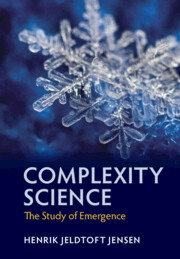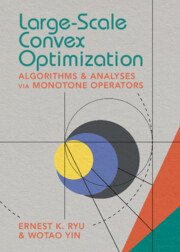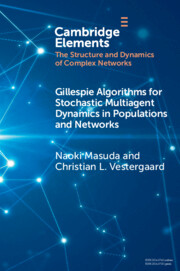Refine search
Actions for selected content:
6950 results in Algorithmics, Complexity, Computer Algebra, Computational Geometry
The bunkbed conjecture holds in the
 $p\uparrow 1$ limit
$p\uparrow 1$ limit
- Part of
-
- Journal:
- Combinatorics, Probability and Computing / Volume 32 / Issue 3 / May 2023
- Published online by Cambridge University Press:
- 14 December 2022, pp. 363-369
-
- Article
- Export citation

Complexity Science
- The Study of Emergence
-
- Published online:
- 13 December 2022
- Print publication:
- 17 November 2022
-
- Textbook
- Export citation

Large-Scale Convex Optimization
- Algorithms & Analyses via Monotone Operators
-
- Published online:
- 12 December 2022
- Print publication:
- 01 December 2022

Gillespie Algorithms for Stochastic Multiagent Dynamics in Populations and Networks
-
- Published online:
- 12 December 2022
- Print publication:
- 05 January 2023
-
- Element
-
- You have access
- Open access
- HTML
- Export citation
A bipartite version of the Erdős–McKay conjecture
- Part of
-
- Journal:
- Combinatorics, Probability and Computing / Volume 32 / Issue 3 / May 2023
- Published online by Cambridge University Press:
- 09 December 2022, pp. 465-477
-
- Article
-
- You have access
- Open access
- HTML
- Export citation
Fluctuations of subgraph counts in graphon based random graphs
- Part of
-
- Journal:
- Combinatorics, Probability and Computing / Volume 32 / Issue 3 / May 2023
- Published online by Cambridge University Press:
- 09 December 2022, pp. 428-464
-
- Article
- Export citation
Acknowledgments
-
- Book:
- Large-Scale Convex Optimization
- Published online:
- 12 December 2022
- Print publication:
- 01 December 2022, pp xiv-xiv
-
- Chapter
- Export citation
Appendix A - Miscellaneous
-
- Book:
- Large-Scale Convex Optimization
- Published online:
- 12 December 2022
- Print publication:
- 01 December 2022, pp 271-272
-
- Chapter
- Export citation
Preface
-
- Book:
- Large-Scale Convex Optimization
- Published online:
- 12 December 2022
- Print publication:
- 01 December 2022, pp xi-xiii
-
- Chapter
- Export citation
12 - Acceleration
- from Part Two: - Additional Topics
-
- Book:
- Large-Scale Convex Optimization
- Published online:
- 12 December 2022
- Print publication:
- 01 December 2022, pp 233-241
-
- Chapter
- Export citation
13 - Scaled Relative Graphs
- from Part Two: - Additional Topics
-
- Book:
- Large-Scale Convex Optimization
- Published online:
- 12 December 2022
- Print publication:
- 01 December 2022, pp 242-270
-
- Chapter
- Export citation
Contents
-
- Book:
- Large-Scale Convex Optimization
- Published online:
- 12 December 2022
- Print publication:
- 01 December 2022, pp vii-x
-
- Chapter
- Export citation
10 - Maximality and Monotone Operator Theory
- from Part Two: - Additional Topics
-
- Book:
- Large-Scale Convex Optimization
- Published online:
- 12 December 2022
- Print publication:
- 01 December 2022, pp 197-206
-
- Chapter
- Export citation
11 - Distributed and Decentralized Optimization
- from Part Two: - Additional Topics
-
- Book:
- Large-Scale Convex Optimization
- Published online:
- 12 December 2022
- Print publication:
- 01 December 2022, pp 207-232
-
- Chapter
- Export citation
8 - Admm-Type Methods
- from Part Two: - Additional Topics
-
- Book:
- Large-Scale Convex Optimization
- Published online:
- 12 December 2022
- Print publication:
- 01 December 2022, pp 160-189
-
- Chapter
- Export citation
7 - Stochastic Optimization
- from Part Two: - Additional Topics
-
- Book:
- Large-Scale Convex Optimization
- Published online:
- 12 December 2022
- Print publication:
- 01 December 2022, pp 147-159
-
- Chapter
- Export citation
5 - Randomized Coordinate Update Methods
- from Part One: - Monotone OPerator Methods
-
- Book:
- Large-Scale Convex Optimization
- Published online:
- 12 December 2022
- Print publication:
- 01 December 2022, pp 105-119
-
- Chapter
- Export citation
6 - Asynchronous Coordinate Update Methods
- from Part One: - Monotone OPerator Methods
-
- Book:
- Large-Scale Convex Optimization
- Published online:
- 12 December 2022
- Print publication:
- 01 December 2022, pp 120-144
-
- Chapter
- Export citation
References
-
- Book:
- Large-Scale Convex Optimization
- Published online:
- 12 December 2022
- Print publication:
- 01 December 2022, pp 273-298
-
- Chapter
- Export citation
1 - Introduction and Preliminaries
-
- Book:
- Large-Scale Convex Optimization
- Published online:
- 12 December 2022
- Print publication:
- 01 December 2022, pp 1-20
-
- Chapter
- Export citation




















































